Integration of 3D Geological Modeling and Geothermal Field Analysis for the Evaluation of Geothermal Reserves in the Northwest of Beijing Plain, China
Abstract
:1. Introduction
2. Description of the Study Area
3. Data and Methods
3.1. 3D Geological Modeling Data
3.2. Present Geothermal Field Data
3.3. 3D Modeling of Geological Structure and Isothermal Surfaces
- Create a set of initial interfaces. The projection of the interface on the horizontal plane was divided into triangle meshes, and the meshes were interpolated to obtain the initial surface. Then, we arranged the encryption points on the initial surface and performed 3D surface subdivision and Kriging interpolation to generate various interfaces with complex shapes. The set of initial interfaces included the ground surface, fault planes, and stratigraphic interfaces. Figure 4 shows a screenshot of the upper interface of the magmatic intrusions created in ROCKModel.
- Create the wire frame of the model. By the intersection searching module, the intersection wires between two interfaces were obtained. We combined the boundary of the interfaces to generate the initial wire frame, and then found the intersection between any two boundaries in the initial wire frame. We inserted each intersection as a unique object into the corresponding boundary. After that, we dispersed the boundary to generate the set of simple arcs and created the wire frame of a model composed of simple arcs, thereby forming a boundary contour of all the original interfaces.
- Interface modification and reconstruction. According to the intersection of the interfaces, we modified the boundary contours of the original interfaces and deleted the extra parts. The modified boundary contours were used as a constraint, and all interfaces were reconstructed and interpolated.
- Block searching and attribute classification. By the function of the block searching module, we found 43 closed blocks. All the original interfaces had been converted into actual seamless interfaces. According to the attributes, the blocks were classified. Finally, the 3D geological model was completed [32].
3.4. Improved Volumetric Method
4. Results and Discussion
4.1. Integration of 3D Geological Model and Isothermal Surfaces
4.2. Present Geothermal Field Analysis
4.3. Resources Calculation Results
4.4. Geothermal Resources Distribution
5. Conclusions
- The average elevations of 25 °C, 40 °C, and 60 °C isothermal surfaces were −415 m, −1282 m, and −2613 m, respectively. The total heat reservoir volume in the study area was 4.88 × 1011 m³. The temperature intervals of 25–40 °C, 40–60 °C, above 60 °C accounted for about 17.6%, 37.9%, and 41.7% of the total heat reservoir volume. The study area mainly belonged to the low-temperature geothermal resources, and the resources of about 60 °C were relatively abundant and easy to be developed and utilized.
- In the study area, the heat flow values ranged from 49 to 99 mW m−2, which increased from northwest to southeast overall. By the comprehensive analysis, in Parts Ⅰ, Ⅱ, Ⅲ, and other parts, the sites whose geothermal conditions were relatively good were Xueshancun, Guanniufang, Shangniantou, and Zhenggezhuang, respectively.
- The total volume of geothermal fluid was 2.42 × 109 m³, and the volume of exploitable fluid was 6.04 × 106 m³. The total reserves of the geothermal resources were 5.42 × 1019 J. The recoverable geothermal reserves were 8.14 × 1018 J, which was equivalent to the thermal value of standard coal of 2.78 × 108 t. The geothermal resources in the study area had good potential, which could provide support for the green development of Changping New Town by rational exploitation and utilization.
Author Contributions
Funding
Conflicts of Interest
Appendix A
| Borehole Number | Borehole Depth (m) | Hole Bottom Temperature (°C) | Q | K-J | O-Є | Qn | Jx | Ch |
|---|---|---|---|---|---|---|---|---|
| ZK1 | 1001.7 | 28.5 | 1.21 | - | - | - | - | - |
| ZK2 | 2208.6 | 48.5 | 2.71 | - | - | - | 1.06 | - |
| ZK3 | 1354.7 | 35.3 | 3.01 | - | - | - | - | - |
| ZK4 | 1501 | 35.1 | 1.95 | - | - | - | - | - |
| ZK5 | 1502 | 28.2 | - | - | - | - | 0.92 | - |
| ZK6 | 1966.8 | 44.8 | 1.73 | - | - | - | 0.95 | 2.67 |
| ZK7 | 3315 | 49.7 | - | - | - | - | 1.05 | 1.28 |
| ZK9 | 3800 | 64.4 | - | 1.23 | 0.9 | 1.07 | 1.45 | - |
| ZK10 | 3801.1 | 56.7 | - | 1.01 | 0.78 | 1.09 | 1.34 | - |
| ZK11 | 3779 | 54.5 | - | 1.33 | 1.06 | 1.47 | 1.06 | - |
| ZK12 | 3650.4 | 57.5 | - | 0.9 | 0.52 | 1.49 | 1.42 | - |
| ZK13 | 3616.1 | 56 | - | 1.1 | 0.67 | 0.73 | 1.43 | - |
| ZK14 | 2538.4 | 46 | - | - | - | - | 1 | - |
| ZK15 | 2850 | 58 | 2.45 | - | - | 1.44 | 1.27 | - |
| ZK16 | 3001.5 | 63.3 | 2.79 | 1.52 | - | 1.57 | 1.4 | - |
| ZK17 | 2839.8 | 61.6 | 3.19 | - | 1.13 | 1.23 | 0.98 | - |
| ZK23 | 1618.9 | 45.5 | 3.02 | - | - | - | 1.94 | - |
| ZK25 | 2480.2 | 60 | 5 | - | 2.08 | 2.26 | 1.29 | - |
| ZK26 | 1603.8 | 56.8 | 6.81 | 2.53 | 1.62 | - | 1.38 | - |
| ZK29 | 2500 | 73.8 | 5.2 | - | 2.26 | 2.9 | 1.89 | - |
| ZK30 | 2540 | 74.4 | 5.18 | - | 2.02 | 2 | 1.68 | - |
| ZK31 | 2495.1 | 71 | 3.01 | 4.2 | - | 2.58 | 0.87 | - |
| Average Value | 3.38 | 1.73 | 1.30 | 1.65 | 1.28 | 1.98 |
References
- Rybach, L. Geothermal energy: Sustainability and the environment. Geothermics 2003, 32, 463–470. [Google Scholar] [CrossRef]
- Xu, Z.; Zhou, X.; Chen, R.; Shen, Y.; Shang, Z.; Hai, K. Numerical simulation of deep thermal groundwater exploitation in the Beijing plain area. Water 2019, 11, 1494. [Google Scholar] [CrossRef] [Green Version]
- Zhang, X. Development of geothermal resources in China: A review. Earth Sci. 2018, 29, 452–467. [Google Scholar] [CrossRef]
- Jiang, Y.; Lei, Y.; Liu, J. Economic impacts of the geothermal industry in Beijing, China: An input-output approach. Math. Geosci. 2019, 51, 353–372. [Google Scholar] [CrossRef]
- Lei, H.; Zhu, J. Numerical modeling of exploitation and reinjection of the Guantao geothermal reservoir in Tanggu District, Tianjin, China. Geothermics 2013, 48, 60–68. [Google Scholar] [CrossRef]
- Tian, B.; Kong, Y.; Gong, Y.; Ye, C.; Pang, Z.; Wang, J.; Zhang, D. An improved volumetric method of geothermal resources assessment for shallow ground combining geophysical data. Renew. Energy 2020, 145, 2306–2315. [Google Scholar] [CrossRef]
- Pocasangre, C.; Fujimitsu, Y. A Python-based stochastic library for assessing geothermal power potential using the volumetric method in a liquid-dominated reservoir. Geothermics 2018, 76, 164–176. [Google Scholar] [CrossRef]
- Li, Q.; Zhang, H.; Cao, D.; Dong, Q.; Cui, Y.; Chen, C. Usage, status, problems, trends and suggestions of 3D geological modeling. Geol. Explor. 2016, 52, 759–767. [Google Scholar]
- Guglielmetti, L.; Comina, C.; Abdelfettah, Y.; Schill, E.; Mandrone, G. Integration of 3D geological modeling and gravity surveys for geothermal prospection in an Alpine region. Tectonophysics 2013, 608, 1025–1036. [Google Scholar] [CrossRef]
- Fuchs, S.; Balling, N.; Mathiesen, A. Deep basin temperature and heat-flow field in Denmark-New insights from borehole analysis and 3D geothermal modelling. Geothermics 2020, 83, 101722. [Google Scholar] [CrossRef]
- Fulignati, P.; Marianelli, P.; Sbrana, A.; Ciani, V. 3D geothermal modelling of the Mount Amiata hydrothermal System in Italy. Energies 2014, 7, 7434–7453. [Google Scholar] [CrossRef] [Green Version]
- Xu, N.; Tian, H. Development of 3D seamless engineering geological modeling system. Rock Soil Mech. 2009, 30, 2385–2391. [Google Scholar]
- Standardization Administration of the People’s Republic of China. GB/T 11615-2010; Geologic Exploration Standard of Geothermal Resources; Standards Press of China: Beijing, China, 2010. [Google Scholar]
- Lei, X.; Hu, S.; Yang, Q.; Zheng, J.; Juan, L.; Chen, L.; Chao, Z.; Peng, G. Characteristics of hydrothermal system and its origin of Nankon-Sunhe fault in Beijing. Chin. J. Geophys. 2017, 60, 1838–1850. [Google Scholar]
- Lei, X.; Guan, W.; Guo, T.; Yang, Q.; Hu, S.; Guo, G. Some new ideas on tectonics of karst aquifer system of Gaoyakou-Nankou in Changping, Beijing. Chin. J. Geol. 2016, 51, 116–127. [Google Scholar]
- Cheng, S.; Wang, Y. Element geochemistry, petrogenesis and tectonic setting of the Yangfang pluton in Beijing. Geol. Rev. 2010, 56, 205–214. [Google Scholar]
- Sun, Z.; Wang, Y.; Deng, J.; Ji, G.; Xia, X.; Su, S. Temporal sequence of Mesozoic intrusive bodies in the Beijing area and its geological significance. Bull. Mineral. Petrol. Geochem. 2007, 26, 258–262. [Google Scholar]
- Guo, T.; Xue, H.; Fu, C.; Niu, S. The preliminary understanding on hydrogeological investigation of Gaoyakou-Nankou karst region in Changping of Beijing. Urban Geol. 2015, 10, 31–35. [Google Scholar]
- Li, H.; Guo, S.; Cui, L.; Yan, J.; Liu, J.; Wang, B. Review of renewable energy industry in Beijing: Development status, obstacles and proposals. Renew. Sustain. Energy Rev. 2015, 43, 711–725. [Google Scholar] [CrossRef]
- Duan, Z.; Pang, Z.; Wang, X. Sustainability evaluation of limestone geothermal reservoirs with extended production histories in Beijing and Tianjin, China. Geothermics 2011, 40, 125–135. [Google Scholar] [CrossRef]
- Sun, J.; Lei, X.; Li, C.; Zhang, Z.; Meng, M. Geothermal fluid quality evaluation in Changping New Town, Beijing. Urban Geol. 2018, 13, 34–40. [Google Scholar]
- Pang, Z.; Huang, S.; Hu, S.; Zhao, P.; He, L. Geothermal studies in China: Progress and prospects (1995–2014). Chin. J. Geol. 2014, 49, 719–727. [Google Scholar]
- Wang, G.; Zhang, W.; Lin, W.; Liu, F.; Zhu, X.; Liu, Y.; Li, J. Research on formation mode and development potential of geothermal resources in Beijing-Tianjin-Hebei region. Geol. China 2017, 44, 1074–1085. [Google Scholar]
- Guo, G.; Liu, W.; Xin, B. Current situations and discussions on karst groundwater resources exploration in Beijing. South-to-North Water Divers. Water Sci. Technol. 2011, 9, 33–36. [Google Scholar]
- Wang, D.; Zhang, S.; Liu, X.; Zhang, Y.; Wang, R. A study on the character of late Quaternary activity of the Nankou-Sunhe fault. China Acad. J. Electron. Publ. House Rights Reserved 2006, 19, 50–59. [Google Scholar]
- The Beijing Municipal Bureau of Geology and Mineral Resources. The Rock Formation of Beijing; China University of Geosciences Press: Wuhan, China, 1996; pp. 39–48. [Google Scholar]
- Wang, S.; Pang, Z.; He, T.; Lin, P.; Liu, K.; Liu, J. Study on the permeability of carbonate rock geothermal reservoir in Beijing. J. Eng. Geol. 2014, 22, 647–654. [Google Scholar]
- Mao, X.; Wang, X.; Li, K.; Guo, S. Sources of heat and control factors in geothermal field. Earth Sci. 2018, 43, 4256–4266. [Google Scholar]
- Shi, X.; Qiu, X.; Xia, K.; Zhou, D. Characteristics of surface heat flow in the south China sea. J. Asian Earth Sci. 2003, 22, 265–277. [Google Scholar] [CrossRef]
- Lei, X.; Hu, M.; Li, J.; Jiang, G.; Yang, Q.; Li, Q. Characteristics of heat flow and geothermal distribution in the northwest Beijing plain. Chin. J. Geophys. 2018, 61, 3735–3748. [Google Scholar]
- LV, J. Characteristics of the Geothermal Field in Northern Beijing and the Influence of its Exploitation on Seismic Ground Fluid Behavior. Ph.D. Thesis, Institute of Geology, China Earthquake Administration, Beijing, China, 2004. [Google Scholar]
- Xu, N. 3D engineering geological modeling method suitable for numerical simulation. Chin. J. Geotech. Eng. 2009, 31, 1711–1716. [Google Scholar]
- Muffler, P.; Cataldi, R. Methods for regional assessment of geothermal resources. Geothermics 1978, 7, 53–89. [Google Scholar] [CrossRef]
- Garg, S.K.; Combs, J. A reformulation of USGS volumetric “heat in place” resource estimation method. Geothermics 2015, 55, 150–158. [Google Scholar] [CrossRef]

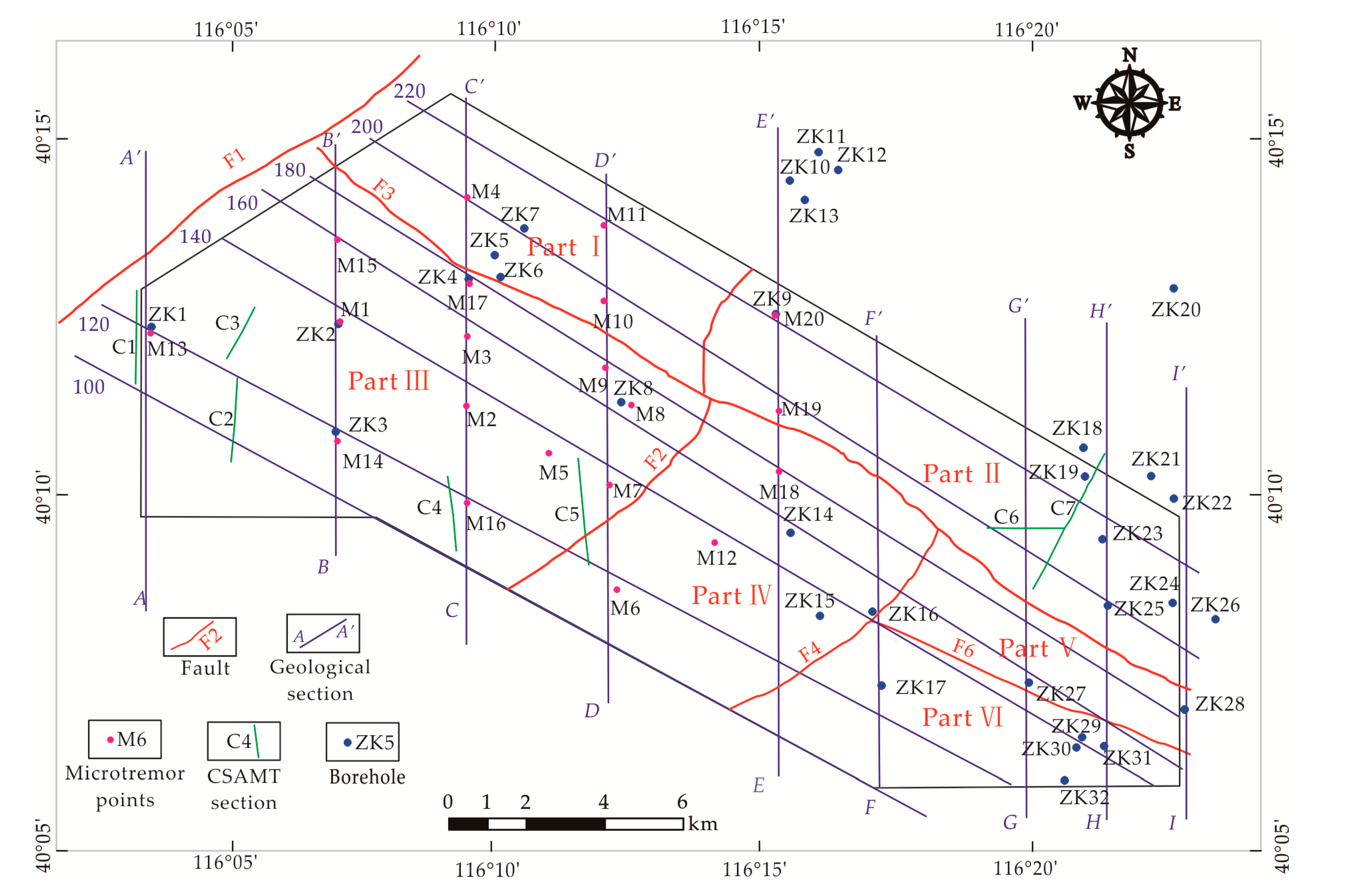

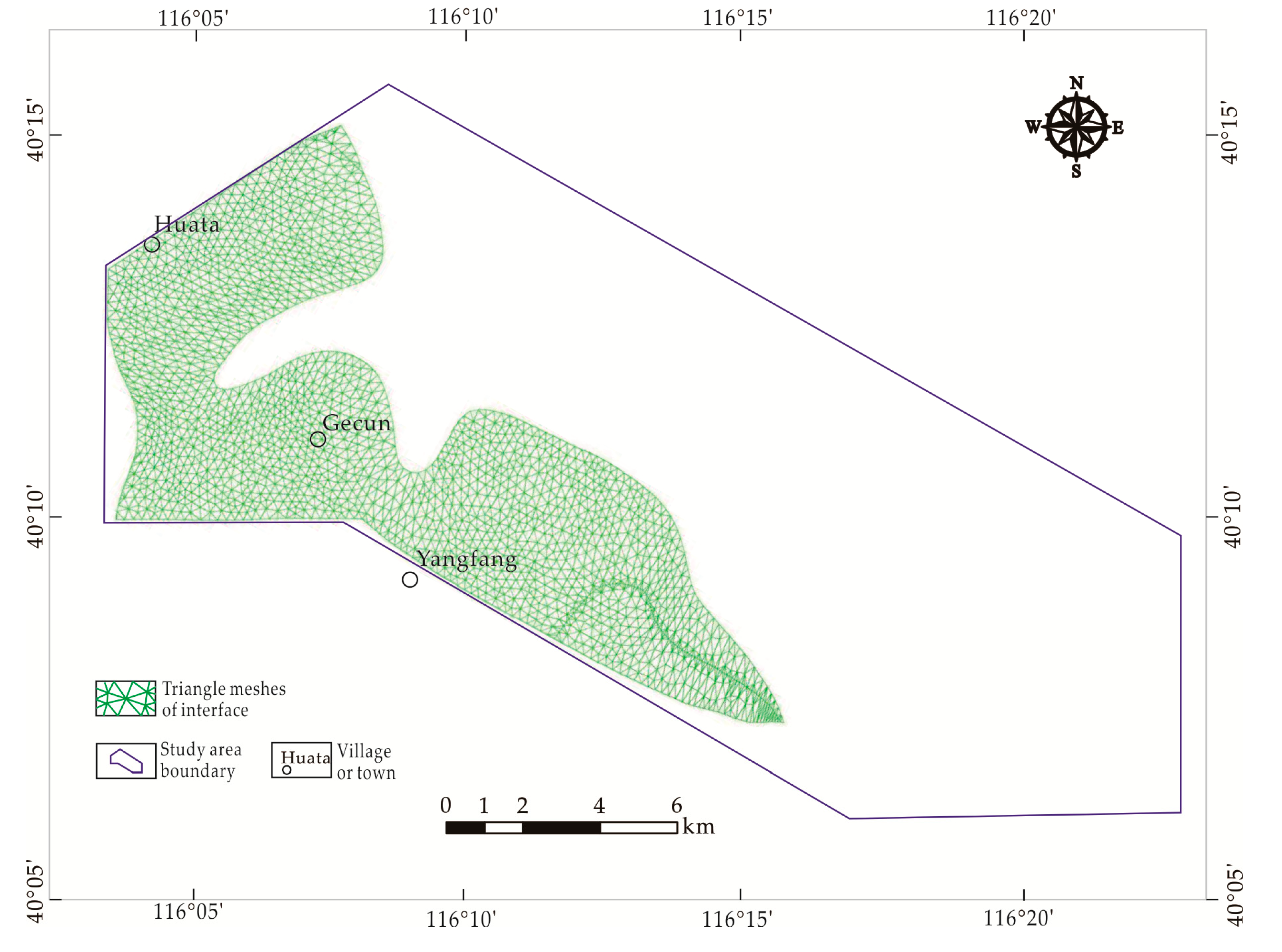
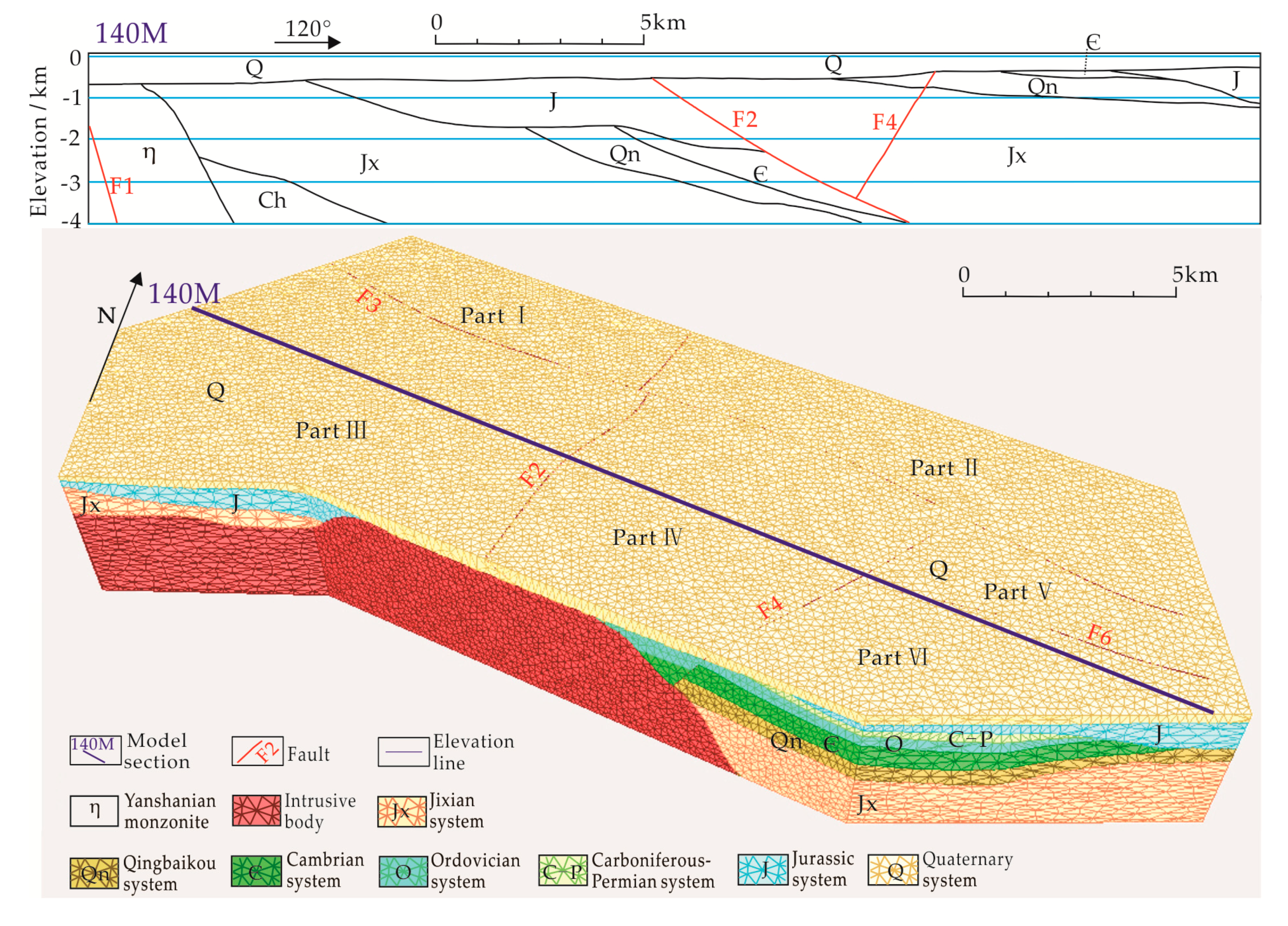
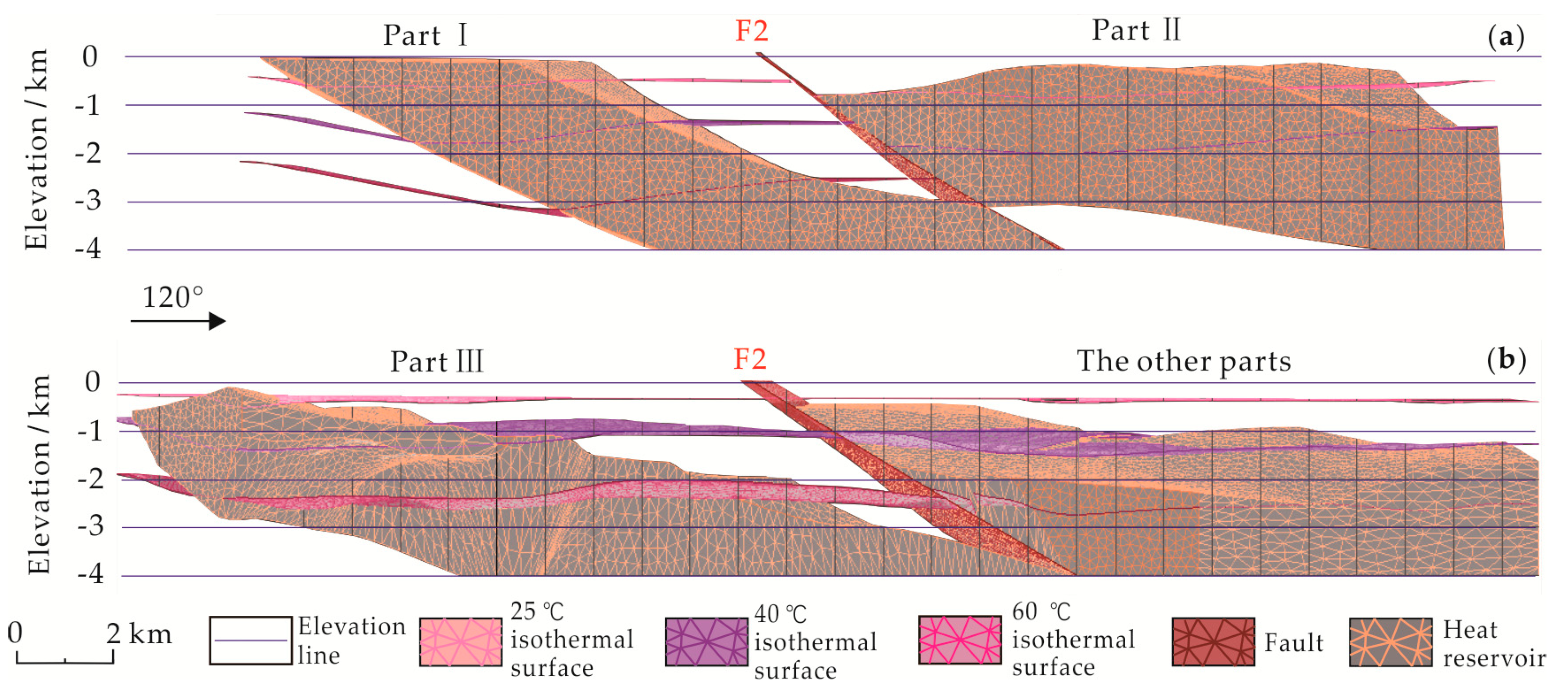

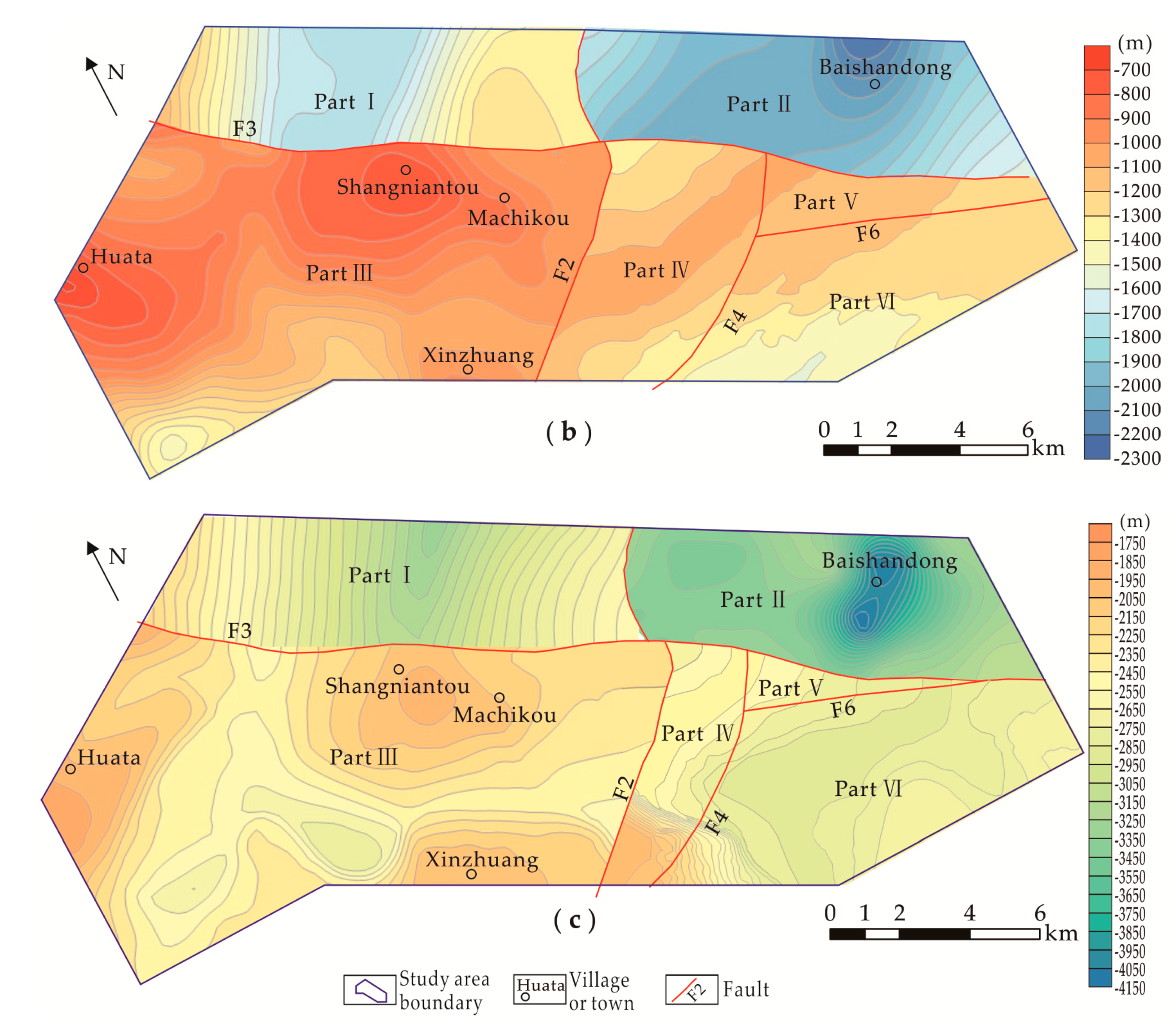
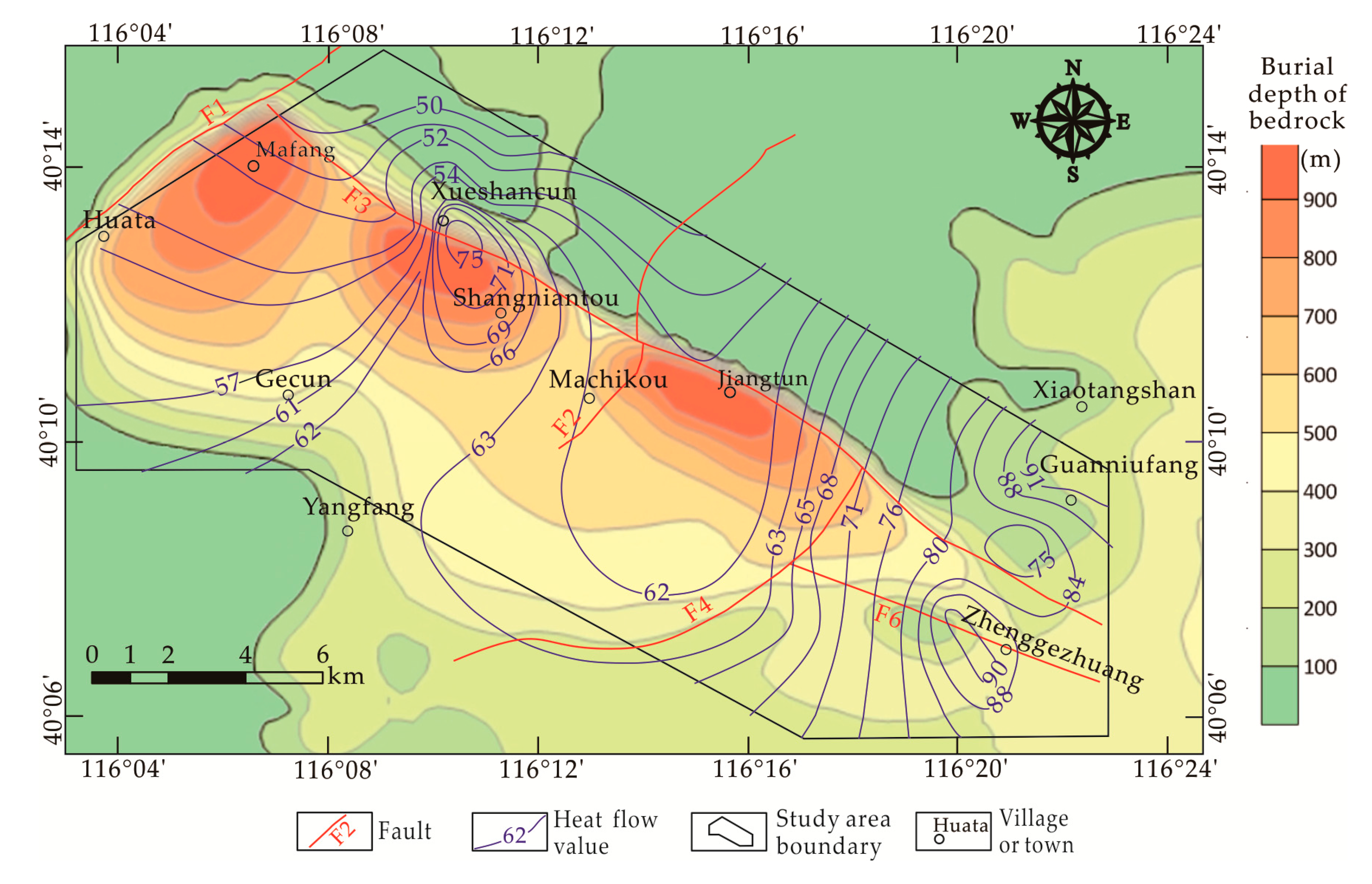

| Temperature Interval | Part Ⅰ | Part Ⅱ | Part Ⅲ | The Other Parts | Whole |
|---|---|---|---|---|---|
| Total volume (1010 m³) | 8.65 | 9.28 | 15.08 | 15.75 | 48.76 |
| 15–25 °C | 9.0% | 6.4% | 0.0% | 0.0% | 2.8% |
| 25–40 °C | 26.2% | 34.4% | 7.0% | 13.0% | 17.6% |
| 40–60 °C | 33.3% | 39.3% | 34.9% | 42.6% | 37.9% |
| ≥ 60 °C | 31.4% | 19.9% | 58.2% | 44.4% | 41.7% |
| Region | Volume of Geothermal Fluid (108 m3) | Volume of Exploitable Fluid (106 m3) | Exploitable Reserves of Fluid (1014 J) | Reserves of Geothermal Resources (1018 J) | Recoverable Geothermal Reserves (1018 J) |
|---|---|---|---|---|---|
| Whole | 24.18 | 6.04 | 10.65 | 54.23 | 8.14 |
| Part Ⅰ | 4.73 | 1.18 | 1.31 | 5.54 | 0.83 |
| Part Ⅱ | 4.78 | 1.19 | 1.69 | 7.75 | 1.16 |
| Part Ⅲ | 6.79 | 1.70 | 4.13 | 23.18 | 3.48 |
| The others | 7.88 | 1.97 | 3.52 | 17.76 | 2.66 |
© 2020 by the authors. Licensee MDPI, Basel, Switzerland. This article is an open access article distributed under the terms and conditions of the Creative Commons Attribution (CC BY) license (http://creativecommons.org/licenses/by/4.0/).
Share and Cite
Zhu, Z.; Lei, X.; Xu, N.; Shao, D.; Jiang, X.; Wu, X. Integration of 3D Geological Modeling and Geothermal Field Analysis for the Evaluation of Geothermal Reserves in the Northwest of Beijing Plain, China. Water 2020, 12, 638. https://doi.org/10.3390/w12030638
Zhu Z, Lei X, Xu N, Shao D, Jiang X, Wu X. Integration of 3D Geological Modeling and Geothermal Field Analysis for the Evaluation of Geothermal Reserves in the Northwest of Beijing Plain, China. Water. 2020; 12(3):638. https://doi.org/10.3390/w12030638
Chicago/Turabian StyleZhu, Zhenzhou, Xiaodong Lei, Nengxiong Xu, Dongyue Shao, Xingyu Jiang, and Xiong Wu. 2020. "Integration of 3D Geological Modeling and Geothermal Field Analysis for the Evaluation of Geothermal Reserves in the Northwest of Beijing Plain, China" Water 12, no. 3: 638. https://doi.org/10.3390/w12030638
APA StyleZhu, Z., Lei, X., Xu, N., Shao, D., Jiang, X., & Wu, X. (2020). Integration of 3D Geological Modeling and Geothermal Field Analysis for the Evaluation of Geothermal Reserves in the Northwest of Beijing Plain, China. Water, 12(3), 638. https://doi.org/10.3390/w12030638




